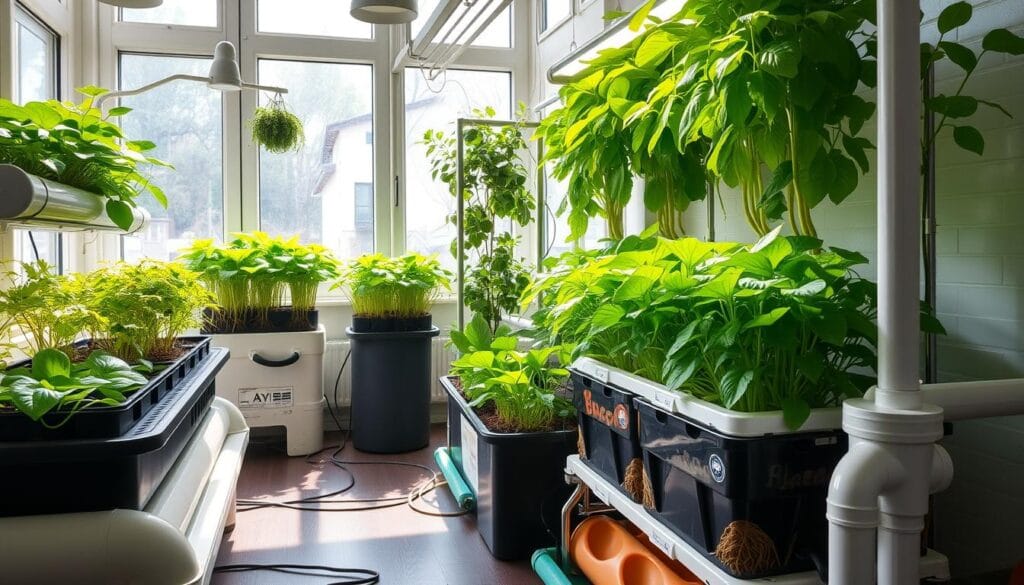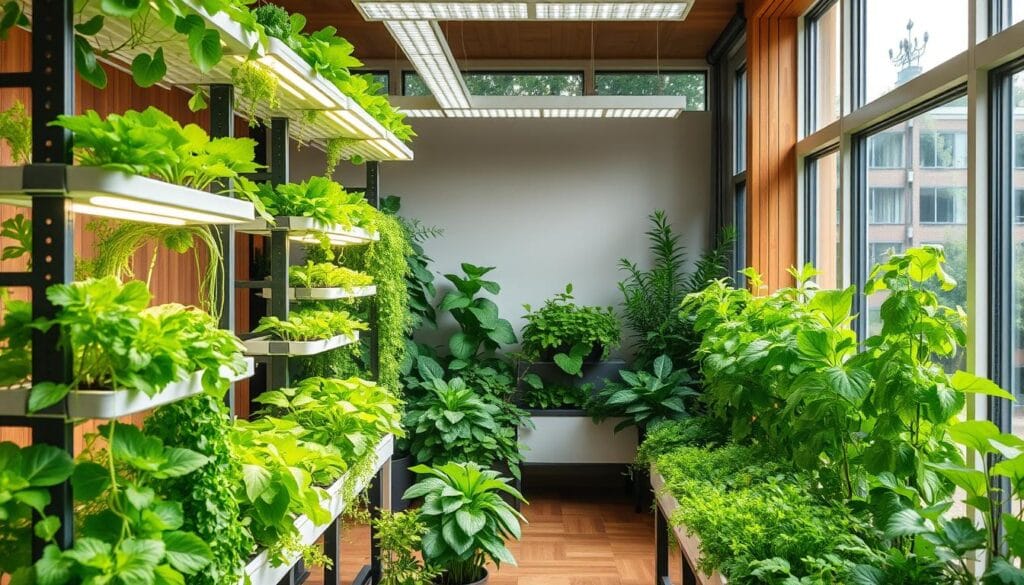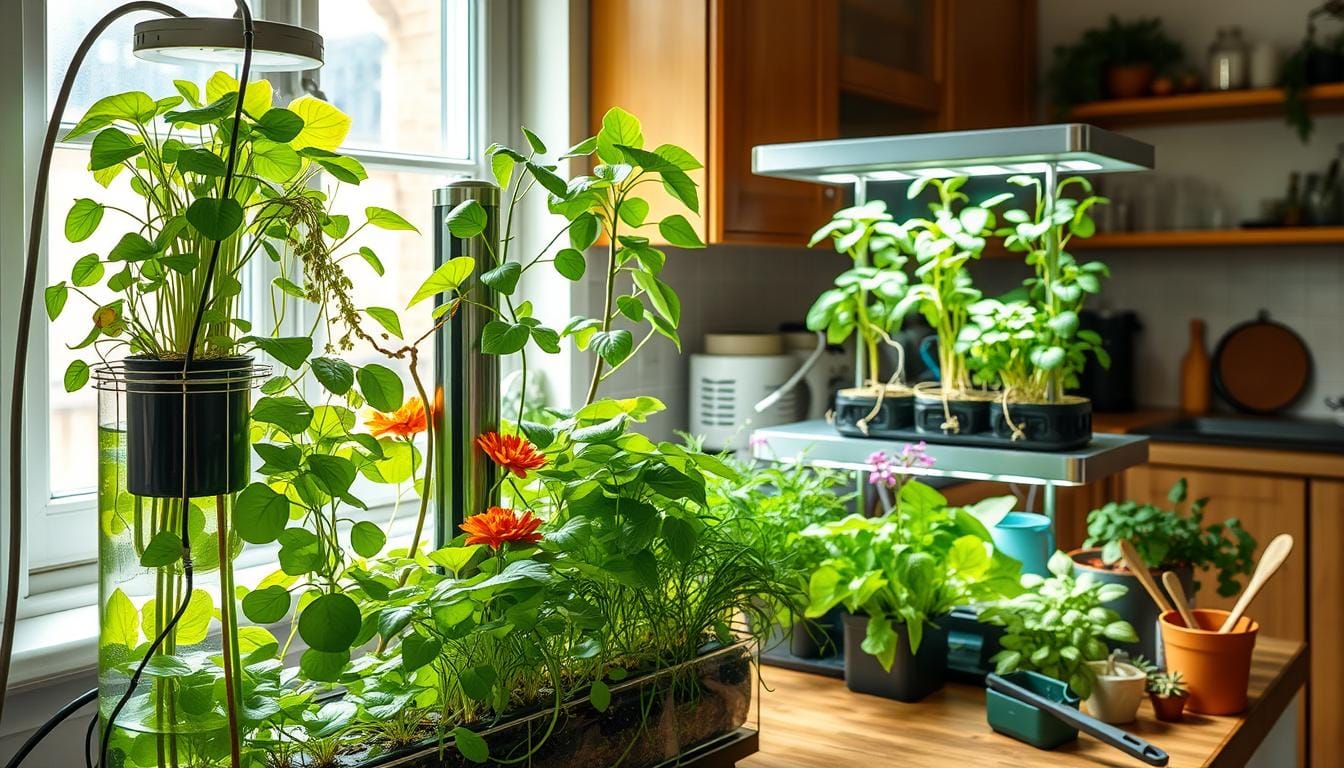Hydroponics Without a Greenhouse opens up endless possibilities for growing fresh, healthy produce all year long. Imagine creating a lush, thriving oasis in your own home—a garden that doesn’t rely on soil or vast outdoor space. Whether you live in a high-rise apartment or a small suburban house, hydroponics makes it possible to enjoy the benefits of gardening without the need for a traditional greenhouse.
In this guide, we’ll explore everything you need to know about hydroponic gardening in the USA. From understanding the basic principles to mastering advanced techniques, you’ll discover how to grow like a pro—no matter your experience level. Plus, you’ll learn how to set up your own system, choose the best plants, and maintain a successful garden even in limited spaces.
If you’ve ever thought gardening was out of reach because of space or climate constraints, think again. Hydroponic Gardening in the USA Without a Greenhouse is your key to unlocking a sustainable and productive gardening experience. Get ready to transform the way you grow food and embrace a greener, more self-sufficient lifestyle.
Key Takeaways
- Hydroponic gardening lets you grow plants in water, without soil, for faster and more efficient growth.
- Beginner-friendly hydroponic systems include the wick, water culture, and ebb and flow systems.
- Hydroponic gardening offers benefits like higher yields, year-round cultivation, and reduced water usage compared to traditional gardening.
- Setting up a hydroponic garden requires an investment in quality equipment, but the initial cost can be kept under $100.
- Monitoring temperature, humidity, and pH levels is crucial for maintaining a thriving hydroponic garden.
Understanding the Basics of Soil-less Gardening
Are you curious about growing plants without soil? Hydroponics offers an innovative way to achieve exactly that. It’s a way to garden at home without using soil. This method proovides many advantages over traditional gardening techniques.
What is Hydroponics and How it Works
Hydroponics grows plants in water with nutrients. It uses materials like clay or coco coir to support the plants. This method gives plants nutrients directly, leading to faster growth and more produce.
Hydroponic systems can be set up for different plants and conditions. This makes them great for both home and urban gardeners.
Benefits of Growing Without Soil
- Water conservation: Hydroponics uses up to 90% less water than traditional farming.
- Space efficiency: These systems can fit in small spaces, even indoors.
- Reduced pest issues: Without soil, hydroponics cuts down on pests and diseases.
- Faster growth and higher yields: Hydroponic gardens grow plants faster and produce more.
Common Misconceptions About Hydroponic Growing
Many think hydroponics is hard to start or keep up. However, it’s much simpler than it might seem at first. Hydroponic systems can fit any budget and growing needs. With some help and practice, anyone can grow plants without soil at home.
Essential Equipment and Materials for Your Indoor Setup
Starting your backyard hydroponic garden or urban hydroponics without greenhouses needs the right tools. Whether you’re new or have experience, the right stuff makes a big difference. It helps your indoor hydroponic system grow well.
First, you’ll need a good grow light system. LED or fluorescent lights are top picks. They provide the necessary light for plants while also saving energy. Make sure the lights are the right distance from your plants for the best results.
Water pumps and air stones are key too. The pump keeps the nutrient solution moving. Air stones add oxygen, helping roots grow strong.
- Grow lights (LED or fluorescent)
- Water pumps
- Air stones
- pH testing kits
- Nutrient solutions
- Growing mediums (e.g., rockwool, clay pebbles, coconut coir)
Keeping the pH right is vital for your plants. Get a good pH testing kit. You’ll also need the right nutrient solutions for your plants.
For growing mediums, rockwool, clay pebbles, and coconut coir are good choices. They support and aerate your plants’ roots well.
For newbies, DWC or wick systems are great. They’re easy to start and keep up. As you get more experience, you can try more complex setups.
Choosing the right gear for your indoor hydroponic garden is key. With the right tools and a bit of learning, you’ll grow a great backyard hydroponic garden or urban hydroponics without greenhouses. Pay attention to details and be open to learning to succeed.
Hydroponics Without a Greenhouse: Getting Started
Starting a hydroponic garden indoors is easy, even without a greenhouse. You just need the right spot, control over temperature and humidity, and good lighting. This way, you can grow a lush, soil-free garden right at home.
Choosing the Right Location
Finding the perfect spot for your indoor garden is crucial. It should be close to an electrical outlet for your system and grow lights. The ideal temperature is between 65°F to 80°F, and humidity should be 40% to 70%. Also, make sure it’s well-ventilated to avoid mold.
Temperature and Humidity Control
Keeping the right temperature and humidity is key for your plants. Indoor systems give you more control than outdoor gardens. Use fans, air conditioners, or dehumidifiers to keep things just right for your plants.
Lighting Requirements
Good lighting is essential for indoor gardens. Get high-quality LED grow lights and place them 6-24 inches above your plants. Adjust the lights’ height to match your plants’ needs for the best growth.
With the right location, temperature, humidity, and lighting, you can have a thriving indoor garden. No greenhouse needed. Enjoy the benefits of soil-free gardening all year, no matter the weather outside.
Selecting the Best Hydroponic System for Beginners
Starting your journey into hydroponic gardening in the USA without a greenhouse can be exciting. Choosing the right hydroponic system is key. Some systems are perfect for beginners. Let’s look at the top picks for a successful start in indoor hydroponics.
Beginners often find Deep Water Culture (DWC) or wick systems easy to use. DWC utilizes a reservoir of nutrient-rich water along with an air pump to provide oxygen. Wick systems, however, use a passive method to feed nutrients to your plants.
When picking a hydroponic system, think about space, the plants you want to grow, and maintenance needs. Start with easy plants like lettuce, herbs, or small fruits. This will help you succeed and gain confidence.
| Hydroponic System | Best For | Key Features |
|---|---|---|
| AeroGarden Bounty | Best Overall |
|
| XXXFlower Plant Terrarium | Best for Beginners |
|
| Lettuce Grow Farmstand | Best Large Capacity |
|
By choosing wisely and starting with a beginner-friendly system, you’ll grow a thriving indoor garden. No greenhouse needed!

Choosing Plants and Growing Medium
Starting your soil-less gardening journey means picking the right plants and growing medium. This is key for a successful greenhouse-free hydroponic setup. Choosing beginner-friendly options can help you grow a vibrant indoor garden.
Best Plants for Beginner Hydroponic Gardeners
Leafy greens like lettuce and spinach are great for new hydroponic gardeners. They grow fast and need little care. Herbs like basil and mint are also excellent options. They’re easy to grow and add fresh taste to your meals.
For small fruits, try growing cherry tomatoes or bell peppers. These varieties need less space and do well in indoor hydroponic systems.
Understanding Growing Mediums
The growing medium is vital for plant support and nutrients. Common media used in hydroponic systems include rockwool, clay pebbles, and coconut coir. Each medium affects water retention and aeration differently.
| Growing Medium | Water Retention | Aeration |
|---|---|---|
| Rockwool | High | Moderate |
| Clay Pebbles | Low | High |
| Coconut Coir | Moderate | Good |
Nutrient Solutions and pH Levels
Use hydroponic nutrient solutions for plant nourishment. Keep the pH between 5.5 and 6.5 for best nutrient uptake. Regularly test and adjust nutrient and pH levels for healthy plants.
By picking the right plants, understanding growing mediums, and managing nutrients and pH, you can create a thriving hydroponic garden in the USA.
Setting Up Your First Hydroponic Garden
Are you excited to start your hydroponic gardening journey? Setting up your first hydroponic system is both fun and rewarding. You can grow a lush indoor garden, even without a greenhouse.
First, put together your hydroponic system. Make sure everything is clean and properly connected. Then, fill the reservoir with nutrient solution and adjust the pH level accordingly. Plant your seedlings in net pots with the right growing medium.
- For deep water culture (DWC) systems, make sure the roots are in the solution.
- Set up your grow lights and timers for the right light cycles.
- Keep an eye on water levels, pH, and nutrients, adjusting as needed.
Start small to learn before you grow your hydroponic systems for homes or residential hydroponic setups. This way, you’ll get used to the upkeep and fixing issues in your indoor garden.
| Hydroponic System | Suitable Plants | Maintenance Requirements |
|---|---|---|
| Deep Water Culture (DWC) | Leafy greens, herbs, tomatoes | Monitoring water levels, pH, and nutrient levels |
| Ebb and Flow | Tomatoes, peppers, cucumbers | Adjusting flooding and draining cycles |
| Nutrient Film Technique (NFT) | Lettuce, spinach, strawberries | Maintaining constant nutrient solution flow |
With patience, care, and a desire to learn, you can have a thriving hydroponic garden. It will provide fresh produce throughout the year. Enjoy the journey and the fruits of your labor, right in your home.

Maintaining Your Indoor Hydroponic System
Keeping your backyard hydroponic garden or urban hydroponics without greenhouses healthy needs regular care. Focus on these key daily and weekly tasks to keep your soil-less garden thriving.
Daily and Weekly Maintenance Tasks
- Regularly check water levels and top up as needed to maintain optimal depth.
- Monitor pH and nutrient levels, making adjustments to the solution as recommended for your specific plants.
- Inspect plants for signs of disease, pests, or nutrient deficiencies, and address any issues promptly.
- Clean equipment like pumps, tubing, and grow trays to prevent buildup of algae or mineral deposits.
- Prune away any dead or damaged leaves or stems to encourage healthy growth.
- Replace the nutrient solution completely every 1-2 weeks, depending on plant size and system type.
Troubleshooting Common Issues
Even with careful care, your hydroponic garden may face challenges. Watch out for these common problems and fix them quickly:
- Nutrient deficiencies: Supplement the solution with appropriate additives to correct any imbalances.
- pH imbalances: Adjust the pH up or down using pH up/down solutions to maintain the ideal range.
- Pest infestations: Treat affected plants with organic, hydroponic-safe pest control methods.
- Algae growth: Clean the system thoroughly and reduce light exposure to prevent algae buildup.
Water Management and Testing
Managing water is key to your indoor hydroponic system’s success. Regularly test the water for pH and nutrient levels, making adjustments as needed. Also, change the water every 1-2 weeks to keep it clean and ensure the best growing conditions.
| Parameter | Ideal Range |
|---|---|
| pH | 5.5 – 6.5 |
| Dissolved Oxygen | 6 – 8 ppm |
| Nutrient Concentration | 600 – 1200 ppm |
By keeping up with your hydroponic system’s maintenance, you can enjoy a rich harvest. With the right care, your hydroponic garden will flourish, giving you a steady supply of fresh, tasty produce.
Avoiding Common Beginner Mistakes
Starting your diy hydroponic kits usa or apartment hydroponic gardening journey? Watch out for common mistakes. Planting too many seedlings at once can cause nutrient shortages and slow growth. Also, forget to check pH levels, refill water, and prune regularly, and your garden won’t thrive.
Using regular fertilizers in your hydroponic system is a big no-no. They can clog up your pumps and tubing, harming your setup. Choose hydroponic nutrients specifically designed for your plants instead.
Lighting and environmental control are key. Make sure your plants get the right light and keep the temperature and humidity just right. Start small with easy plants like leafy greens or herbs. This will help you learn before you expand your apartment hydroponic gardening.
Be patient and consistent with your care. Keep track of your plant’s growth, nutrient levels, and any problems. This will help you get better at growing and achieve more success in the future.

